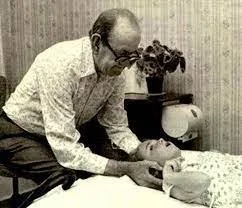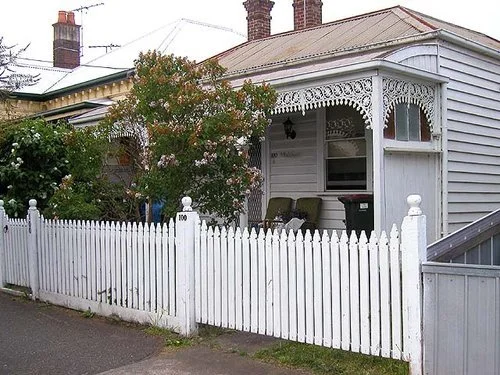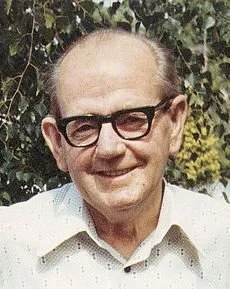Bowen Therapy
A manual therapy that you might call a ‘muscle adjustment’. Bowen is a series of ‘Bowen moves’ used to treat various musculoskeletal conditions causing pain, and may also assist with stress, anxiety, and fatigue. Bowen works with the nervous system to reset the body and realign, to bring back symmetry and restore function. A manual technique developed by Thomas Ambrose Bowen (1916–1982) in Geelong, Australia.
Let me tell you a story…
This is a story of a wonderful man that changed lives, and helped people whenever and wherever he could. People travelled and waited hours to see him.
This was Thomas Ambrose Bowen was born on April 18, 1916 the third child and only son of William and Norah Bowen. He had two older sisters, Norah and Beatrice and a younger sister, Agnes.
Tom Bowen left school when he was young, around 15 years old, and became a carpenter like his father. Tom married Jessie McLean at the Salvation Army, Ringwood in 12 September 1941, and Tom and Jessie went on to have three children, Pam, Barry and Heather.
During their married life Jessie suffered from very bad asthma, often being hospitalised in an effort to help her breathe. This was in her early forties. Tom started to somehow learn how to help her shift her congestion and along with some special medicine obtained from a chemist in the state of Queensland and a change of diet; Jessie received considerable benefit.
It was most unusual in those days to change your diet for an “illness” but Tom was convinced this was the way to Jessie’s recovery. After some years she no longer required the medicine but thanks to Tom’s method and diet she never had to go to hospital again.
Tom also served in World War II, and what he saw affected him, he wanted to help people, help alleviate some suffering.
It was during the 1950’s that Tom became friends with Ernie Saunders, a well known manual therapist who practiced body work influenced by Japanese acupressure. Tom would visit Ernie, and became his mentor. Tom showed natural ability and understanding and it was not long before Tom’s ideas outweighed those of Ernie’s. Tom would develop his own techniques.
It was most unusual in those days to change your diet for an “illness” but Tom was convinced this was the way to Jessie’s recovery. After some years she no longer required the medicine but thanks to Tom’s method and diet she never had to go to hospital again.
Tom also served in World War II, and what he saw affected him, he wanted to help people, help alleviate some suffering.
It was during the 1950’s that Tom became friends with Ernie Saunders, a well known manual therapist who practiced body work influenced by Japanese acupressure. Tom would visit Ernie, and became his mentor. Tom showed natural ability and understanding and it was not long before Tom’s ideas outweighed those of Ernie’s. Tom would develop his own techniques.
In the 1950’s Tom worked for the Geelong Cement Works and it was during this time he became friends with Stan and Irene Horwood, who believed Tom had a unique gift of healing.
Stan and Irene Horwood believe in Tom’s abilities, and invited Tom to use a room in their house to set up a practice. Tom took up their offer, and so every evening after a days work at the Cement Works, he would go to the Horwood’s and treat people.
Tom would treat people from the cement works, football club, and anyone who heard about Tom and needed help.
So life proceeded for Tom Bowen, that he would work all day at the Cement Works, then be at home for about an hour to have dinner with his family, then change his clothes and go to the Horwood’s. Mrs. Horwood ran a hairdressing business at this time and so she assisted with the running the practice, and would later become his trusty secretary.
Toms practice grew through word of mouth. There was no advertising. People would wait outside the Horwood residence for hours to see Tom. Cars would line the street. It became obvious that the practice could not continue this way and so it moved to 99 LaTrobe Tce., Geelong, on a full time basis. He stayed at this address for a few years and then moved to 283 LaTrobe Tce, Geelong where he moved between two rooms.
Tom always had collection boxes for charities in his clinic, he was always trying to help the less fortunate.
There were no appointments at Toms clinic, instead a patient would call and be told the opening hours of the clinic were between 9am – 11am and 1pm – 4pm.
On arrival at the clinic patients were given a number from 1 to 33 in order of presentation. They would wait in the waiting room until their number was called. When all patients were seen during the morning he would then go home for lunch which Jessie had prepared and had waiting for him. He would return just before 1pm and return home when all patients had been seen in the afternoon which would have been some time after 5:30pm. During the evening he would do house calls to people who could not make it into his clinic, such as for disabled children.
Tom also had a Saturday morning clinic for disabled children where they were treated for free. Parents would bring their children to him from many miles away, sometimes traveling up to 4 hours.
Tom was also passionate about sport, and he held a free clinic every Saturday evening for those who had injured themselves playing sport.
Tom Bowen was a compassionate man, if Tom had people attend his clinic who were in desperate circumstances or with disabled children needing extra care, he was very generous. Money was never his priority, Tom just wanted to help people.
Typically Tom would treat up to 65 people per day in the clinic and then they would go off to do the house calls. On more than one occasion, when Tom asked Rene not to close their book so they could see how many they could treat, it was in excess of 100 per day.
Tom was a well respected and loved member of the community, he treated at the sports clubs, injured inmates in the Geelong jail, police officers (being on call at all hours of the day and night), TV personalities, opera singers, and even a Melbourne Cup racehorse.
He was in fact made an honorary member of the Geelong Crime Car squad, for helping the Victorian Police. Only the second member of the public to be given such an award.
Many people came to observe Tom Bowen’s clinic and the therapy he’d developed. He acknowledged six men to have a good understanding of his work. The six he affectionately called his ‘boys’ were: Keith Davis, Kevin Neave, Nigel Love (deceased), Oswald Rentsch, Romney Smeeton and Kevin Ryan.
Romney and Kevin Ryan carried on Tom’s work with the free children’s clinic for another 12 years after Tom’s death in 1982.
Toms work has now been taught world wide, and his legend lives on in Bowen Therapy.
frequently asked questions
What is Bowen Therapy?
A holistic manual technique that consists of sequences of small moves that affect the nervous system, and the soft connective tissue known as fascia.
Can Bowen therapy help anxiety?
When we are anxious or stressed our nervous system is in sympathetic dominance, we are always switched on in ‘fight or flight’ mode. When our Sympathetic and Parasympathetic nervous systems are out of balance, that is sympathetic dominant, the four major functions of our parasympathetic nervous system are affected, which is our digestive system, rest and repair, and reproduction. Our body needs balance so it can repair, restore and digest our food.
Bowen is somehow able to calm the nervous system, reducing that anxiety, as bowen therapy is all about guiding the body to heal itself, it invites the body to slow down and relax, restore. It eases the stressed and anxious brain.
People report good results after Bowen, a reduction in anxiety and a sense of calm.
Is Bowen Therapy good for arthritis?
Bowen therapy promotes healing in the body, it relaxes the muscles, tendons and improves lymphatic drainage, so there is a reduction of inflammation and tension.
Is Bowen Therapy good for sciatica?
Sciatica is tingling sensation, pain or burning sensation that radiates from your lower back to your hip, glute and can run down the back of your leg.
Sciatica is when a herniated disc or bone spur presses on the nerve, and shoots pain down the back of the leg. It is usually one sided.
However, sometimes what we think is sciatica, is actually Piriformis Syndrome, where the piriformis muscle (in the glutes) spasms and starts to compress the sciatic nerve. It can be worse after sitting, long walks, climbing stairs, or running. It often also occurs in pregnancy.
Bowen therapy is great at helping with this condition, as it invites the muscles, tendons and ligaments to relax, and free the sciatic nerve.
What can Bowen Therapy treat?
Bowen can help with all sorts of conditions! Back pain, digestion, fluid retention, ear problems, frozen shoulder, headaches, hernia and heartburn, anxiety, bedwetting, incontinence, TMJ issues, knee pain, hip pain, menstrual issues, pelvic tilt, constipation and diarrhoea, repetitive strain injury (RSI), sciatica, sports injuries, tennis elbow, golfers elbow.
Bowen is well known to provide support for anxiety and stress. Many feel calmer, less anxious and more energetic after a treatment.
We always say, why not try Bowen?
What happens in a Bowen therapy session?
The appointment begins with the client being assessed, then depending on the complaint or condition, the therapist will use a gentle cross-fibre technique on muscles, ligaments or tendons. Bowen is also largely based on meridians and acupressure points, which is why it can treat a variety of issues.
Another point of difference in Bowen therapy is that the therapist will include breaks in the treatment, that is they will leave the room for up to 5 minutes throughout the appointment, the purpose of this is to allow the body to process and respond to the treatment before the next sequence of moves.
Appointments can take up to 45 mins.
Can Bowen Therapy help back pain?
Often back pain is caused by muscle tension, and as Bowen therapy signals the body to release tight muscles and tendons, people report good results with back pain and bowen therapy.
What is Bowen Therapy for dogs?
Bowen therapy can also be used to treat animals too! Dogs, cats and horses have been treated with Bowen. There are bowen therapists who only treat animals. All the same Bowen techniques are used, but adapted for the animal.
How many sessions of Bowen Therapy will I need?
We invite you to have 3 sessions of Bowen, generally once a week. After that, we can reassess and see how the body is feeling.
Monthly or 6 weekly appointments, or even 6 monthly appointments may be the next step, depending on the condition or complaint.
What are the benefits of Bowen Therapy?
Bowen therapy is a calming and restorative treatment, as it allows the body to drop into a relaxed state and provides space for the body to focus on healing itself.
Because of this, Bowen is great at easing a stressed and anxious mind, but Bowen can help with many conditions! From headaches, back pain, digestive issues, bedwetting, TMJ pain, constipation, to RSI and golfers/tennis elbow.
What is Bowen therapy for horses?
Bowen therapy can also be used to treat animals too! Dogs, cats and horses have been treated with Bowen. There are bowen therapists who only treat animals. All the same Bowen techniques are used, but adapted for the animal.
What is the Bowen technique used for?
Bowen therapy can help with many different conditions. From back pain, sciatics, to bedwetting, TMJ pain, knee pain and menstrual issues. It is also wonderful at treating anxiety, as a Bowen session can be very gentle and calming, so it allows the nervous system to quiet down and relax.
Where is your Bowen Therapy clinic?
Loeda is located in the Saltwater estate in Point Cook, but we service Sanctuary Lakes, Altona, Altona Meadows, Werribee, Werribee South, Hoppers Crossing, Williams Landing, Laverton, Seaholme and Tarneit.
How much is Bowen Therapy?
A session of Bowen therapy costs $90 in our clinic. The session can last up to 45 mins. Please note you cannot claim Bowen with private health insurance.
BOOKINGS
all bookings can be made online




